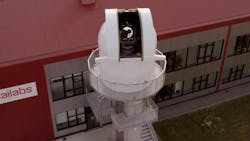New space race: Photonics is revolutionizing satellite networks
From free-space optical communication to inter-satellite laser links, photonics is enabling high-speed, secure, and low-latency data transfer essential for modern satellite constellations.
As of December 31, 2024, there are 10,893 active satellites orbiting Earth, according to a recent estimate,1 plus another 18,701 objects categorized as dead satellites, satellite components, or rocket stages, as well as millions of pieces of tiny space junk.2
Approximately 12% of active satellites are in geostationary orbit at an altitude of 35,786 kilometers to provide always-on communication services like TV and phones, as well as climate monitoring and early warning defense systems. Another 3% are in medium Earth orbit at an altitude of 5,000 to 20,000 kilometers, which is ideal for positioning and navigation services, like GPS. But the vast majority (84%) are in low Earth orbit (LEO) at an altitude of 160 to 1,500 kilometers, which is best for Earth observation, military, and communication satellites. 63% of these LEO satellites comprise megaconstellations of small satellites for internet connection owned by SpaceX.
Satellite internet constellations
First proposed in the 1990s, interest in satellite internet constellations reemerged in the 2010s due to reductions in launch costs and the increased demand for broadband internet access. In 2019, SpaceX made this dream a reality by launching 60 operational Starlink satellites. As of September 2024, the Starlink constellation consists of over 7,000 mass-produced small satellites within LEO, primarily to provide high-speed (50 Mbps to 250 Mbps, depending on the service tier), low-latency (20 to 40 ms) internet services across the globe. Starlink now operates within more than 100 countries and has more than three million individual customers.
With an emphasis on sovereignty, security, and independence, the EU is planning its own IRIS2 project, with a goal of having 290 satellites in orbit by 2030 at a cost of €10.6 billion ($11B). But some see this initiative as being too little, too late, because by the time IRIS is in orbit in 2030, SpaceX will have 12,000 satellites—and Amazon’s Project Kuiper constellation plans for 3,236 satellites during the same period.3 As a result, while there may be a use case for autonomous European government and military applications, IRIS2 will be unable to compete in affordability and scale with U.S. private-sector constellations.
An example of a European private initiative for satellite constellations is Eutelsat OneWeb, which was formed by a merger of France's Eutelsat and the UK’s OneWeb in 2023. Since then, Eutelsat OneWeb has launched more than 600 LEO satellites to provide global high-speed broadband internet services targeting remote and underserved regions. But unlike Starlink, which primarily targets individual consumers, OneWeb aims to deliver high-speed, low-latency internet connectivity to businesses, governments, telecom operators, and community clusters.
Another private European initiative is the German company Rivada Space Networks, which plans to deploy a constellation of 600 LEO satellites—the Rivada Outernet—at 89° inclination by 2028 to provide secure global connectivity for enterprise and government communications.
The satellites, each weighing approximately 500 kilograms, will be manufactured by Terran Orbital at a cost of $2.4 billion, with launch services provided by SpaceX.
The network will comprise satellites interconnected via laser links to ensure ultrasecure and reliable global data transmission with end-to-end latencies comparable to or better than terrestrial fiber. It will be completely detached from the terrestrial internet to provide global point-to-point connectivity—without the need for gateways.
To address the increasing demand for real-time data services, and specific needs for secure and resilient connectivity, the primary markets include telecommunications, business, maritime, energy, and government services.
Inter-satellite comms
A critical factor that unites the new generation of satellite constellations is the use of advanced photonics technologies to enhance inter-satellite communications. Older satellite networks’ satellites don’t communicate with each other directly. Instead, they typically send radio frequency (RF) signals back to a ground receiver, which then transmits the data to the next satellite. This system is too slow for applications like a global internet that requires high-speed, low-latency, seamless, and global coverage. So modern satellite constellations use free-space optical communication (FSO) techniques, which involve transmitting data by lasers within the near-infrared (NIR) to enable the high-speed data transfer between satellites without relying on ground stations.
A major advantage of FSO over RF communication is that, while RF frequencies range between 4 and 12 GHz, FSO uses laser beams within the NIR bands between 785 and 1550 nm at frequencies above 300 GHz. With this much higher frequency, more data is encodable inside the waveform, which results in effective bandwidth increases of 10 to 100x compared to RF.
Laser communications also achieve a significant reduction in latency with near-instantaneous data transfer with delays 10 to 20 ms, compared to the hundreds of milliseconds experienced with RF. Another advantage of FSO over RF is enhanced security because highly focused laser beams are more difficult to intercept than radio waves, which makes laser communication links less vulnerable to eavesdropping and potential jamming.
Finally, laser communication systems can be designed with smaller and lighter components compared to their RF counterparts, which is beneficial for smaller satellites or for limited payload capacity situations.
Satellite-Earth comms
While Starlink customers access the internet through a special ground-based dish, most newer satellite constellations require ground stations equipped with advanced optical receivers and transmitters to handle the high data throughput from the satellite constellation.
Although photonics technology offers significant advantages over traditional RF systems, optical communications also have drawbacks: namely, laser beams require higher pointing accuracy due to their smaller beam divergence, and optical beams can be more impacted by the Earth’s atmosphere because water vapor and other atmospheric particles can absorb or scatter the light and cause signal loss.
To address these issues, French company Cailabs, a manufacturer of optical ground stations, developed a multi-plane light conversion (MPLC) technology to overcome atmospheric turbulence and enable high-performance optical ground stations for satellite communications. In this process, light passes through a series of specially designed layers, and each one slightly alters the light's shape or direction and transforms it into the desired pattern or structure.
This solution enables high-capacity optical links (up to 100 Gbps) with low probability of detection/interception, which eliminates the need for RF spectrum licensing.
Cailabs’ stations comply with Consultative Committee for Space Data Systems (CCSDS) and Space Development Agency (SDA) standards and are agnostic in terms of throughput rate, protocol, and modulation format.
Optical components
Transceivers. Created in the United Arab Emirates in 2020, the Technology Innovation Institute (TII) is a research and development center that operates in various fields of applications, including space. Among their activities, they are creating optical systems that meet space requirements in terms of being lightweight, compact, and able to handle the harsh space environment. These systems can also be used for ground-to-ground optical communication as transceivers capable of handling data speeds of up to 1 Gbps over distances of up to 1,000 km, covering LEO.
They are also working on increasing data speeds using advanced techniques like quadrature amplitude modulation (QAM) and optical angular momentum (OAM). OAM is especially promising because it theoretically allows endless possibilities for encoding data, which can greatly improve optical communication.
To ensure reliable communication, the TII monitors local weather conditions like wind speed, temperature, and humidity to build a weather database for predicting how weather affects optical links and to determine the best times for communication based on atmospheric conditions.
French company Exail, a high-tech industrial group, is also a manufacturer of space-grade optical components, leveraging 20 years of partnership with Airbus Defense & Space (ADS) for the delivery of Astrix fiber-optic gyroscope technology.
In 2024, Exail played a key role in the successful very high-speed (gigabits) optical communication tests between the TELEO geostationary in-orbit demonstrator and ground stations. Developed by ADS and hosted aboard the Arabsat Badr-8 satellite, TELEO is equipped with Exail’s fully integrated optical transceiver.
Another Exail optical component is their multiplexer/demultiplexer based on free-space micro-optical assemblies that will be space qualified (TRL6) in 2025 within the CO-OP project, a French consortium that plans to deliver a 100-Gbps space optical link.
Optical filters. To provide wavelength selectivity and beam steering functionality, optical filters are crucial for ensuring the high performance and efficiency of both inter-satellite communication and optical ground stations. Since 1998, the Canadian company Iridian Spectral Technologies has manufactured a range of custom filters designed to deliver “more signal, with less background.”
As an example, Iridian’s solar rejection filter allows the transmission of the inter-satellite communication band (typically around 1550 nm) between satellites, while blocking the background solar radiation, to provide improved signal-to-noise and help minimize solar heating inside the satellite.
Iridian also makes dichroic filters that steer and combine the different send and receive wavelength channels, as well as laser bandpass filters for cleaning up the signal at the detectors.
Digital signal processing. Established in 2021 and based in France, MIMOPT Technology specializes in developing innovative digital signal processing (DSP) solutions to facilitate reliable connections for both Earth-to-satellite and inter-satellite communications. Dealing with signal distortion caused by high-power optical amplifiers is a major challenge that can reduce performance, especially with advanced data formats needed for efficient data transfer.
Problems like signal interference and distortions (self-phase modulation, cross-phase modulation, and four-wave mixing) are common in systems with many data channels. To address this, MIMOPT uses its advanced digital signal processing tools to create solutions that reduce interference and distortion and help achieve data speeds of 100 Gbps per channel for satellite systems.
MIMOPT also offers a versatile simulator platform designed to model and customize optical end-to-end transmission systems to meet client specifications. This platform assists in system engineering, optimization, and upgrades—and ensures optical satellite communication systems achieve optimal performance.
FSO challenges and innovations
Free-space optical (FSO) communication offers groundbreaking advantages over traditional RF systems, but it also faces a unique set of challenges that require innovative solutions. One of the most significant issues is atmospheric interference. Weather conditions such as rain, fog, and atmospheric turbulence can scatter or absorb optical signals, which leads to reduced reliability. To counter it, advancements like multi-plane light conversion technology stabilize signals by mitigating the effects of turbulence. Moreover, hybrid communication systems are emerging as a practical solution. These systems combine the strengths of FSO and RF technologies, with RF acting as a backup during adverse weather to ensure uninterrupted connectivity.
Another major challenge is maintaining precise alignment between transmitting and receiving terminals. This is particularly complex for moving satellites, where even minor deviations can disrupt communication. To address it, next-gen satellites are equipped with phased array antennas to electronically steer their beams without mechanical parts, which enables rapid and precise adjustments. AI-driven systems are also being deployed to optimize beam alignment, predict atmospheric disruptions, and adapt communication protocols in real time to ensure seamless operation.
The cost to develop and deploy satellite constellations remains a formidable barrier. The initial investments in satellite manufacturing, launch services, and ground station infrastructure are substantial. But advancements in miniaturization and modular design are gradually driving down costs, fostering scalability, and enabling wider adoption.
Space debris and orbital congestion present additional challenges that must be addressed for the sustainable growth of satellite networks. Modern satellites are now equipped with argon thrusters to allow them to maneuver within orbit and deorbit safely at the end of their operational life. Despite these advancements, the problem of removing existing debris remains unsolved.
As far as overcrowding, a May 2024 report from SpaceX says that during the previous months, Starlink satellites made nearly 50,000 collision-avoidance maneuvers to dodge orbiting objects—such as other Starlink satellites, spacecraft owned by other operators, and pieces of space debris. This is nearly double the number made during the previous six months.4 With more than 60,000 active satellites predicted to be in orbit by 2030,5 the increased risk of collision needs to be addressed, and it can only be done effectively via international cooperation and regulation.
Future outlook
FSO communications will continue to enable the development of high-speed, resilient communication networks for Earth observation and global internet coverage, and future systems will support quantum key distribution to pave the way for secure quantum communications in space. These advancements not only enhance data security, but also open up new possibilities for applications requiring tamper-proof transmissions.
REFERENCES
- See https://planet4589.org/space/stats/acdec.html.
- See www.nasa.gov/headquarters/library/find/bibliographies/space-debris.
- See https://spacenews.com/europes-iris%C2%B2-constellation-faces-challenges-of-timing-scaling-and-competition.
- See www.space.com/spacex-starlink-50000-collision-avoidance-maneuvers-space-safety.
- See www.gov.uk/government/news/the-future-space-environment.
About the Author
Jérémy Picot-Clémente
Jérémy Picot-Clémente is photonics technologies manager for the European Photonics Industry Consortium (EPIC), and is based in Auvergne-Rhône-Alpes, France.




